I have this cheap DC power supply.
- Tekpower DC Variable Power Supply, 1.5-15 V @ 2A, HY152A

It says it is limited by 15 V or 2 A. My question is, if I short it out, can it damage the unit? Is there anyway I can hurt myself with this?
I have this cheap DC power supply.

It says it is limited by 15 V or 2 A. My question is, if I short it out, can it damage the unit? Is there anyway I can hurt myself with this?
Most benchtop power supplies have a current limiter built-in, but there's only one way to know (apart from trying and possibly damaging the device): read the specifications. If it doesn't have any, don't buy it.
There are two different ways of current-limiting. The simple method just drops the voltage but keeps supplying the full current, which may cause damage to your circuit. A more advanced method is foldback current limiting, where shorting causes to drop the current as well. The power supply needs to be reset to go back to normal operation.
More expensive benchtop power supplies have adjustable current limiting.
From the information given it is likely but not certain that it is short circuit protected.
A site referenced below says that it is.
Caveat Emptor (and look inside - see below)
It is quite likely, based on cost and common practice that it uses a version of the LM317 regulator, which is short circuit protected. Your supply voltage output has a lower limit of 1.5 volts, whereas the LM317 allows output from 1.25 Volts and up. (Given the analog meter output and the worst case output minmum of 1.3V the claimed 1.5V minimum matches the LM317). There is a "big brother" LM350 regulator available but current is above 2A.
SO - if you are comfortable with looking inside your supply * and there is an LM317 visible then the supply is protected against short circuiting. * - Probably 4 screws underneath the case - with that style of case they are probably near the rubber feet and possibly also holding the feet on.
The supply is advertised on some sites as suitable for use wih tatooing machines - probably because the voltage and currrent suits the motors used. The way they are used probably operates the supply in current limited mode, also suggesting safe short circuiting.
If it does not contain an LM317 it still MAY be short circuit safe - and the site below says it is.
This site says that the HY152A power supply is short circuit protected. They claim -
Load / voltage / Current:
Fairly obviously (hopefully) if a supply limits current to 2A when the load gets excessive, then the voltage supplied MUST drop. Failure to do this would violate Ohms law and break most of the laws of physics coincidentally. ie
For a given current, if you reduce R (= heavier load) then Voltage must reduce proportionately. If you increase load (decrease R) and voltage and current stays the same then Scotty gets upset ("Y' canna break the laws a' Physics!)
If you want current limiting and your load cannot tolerate low voltage without damage for some reason then you need an alawrm or a complete cutoff, regardless of how good your supply is
LM317: The LM317 naturally current limits first just by "running out of steam" - there is only so much current that it is able to pass. Then in most cases, the voltage drop across the regulator x the current will cause heating and temperature rise. If the heatsinking is not able to limit temperature rise to an acceptable level the IC has internal circuitry that further limits current so that current will fall to maintain temperature at an acceptable limit. This will usually result in a much lower than 2A current until the short is removed.